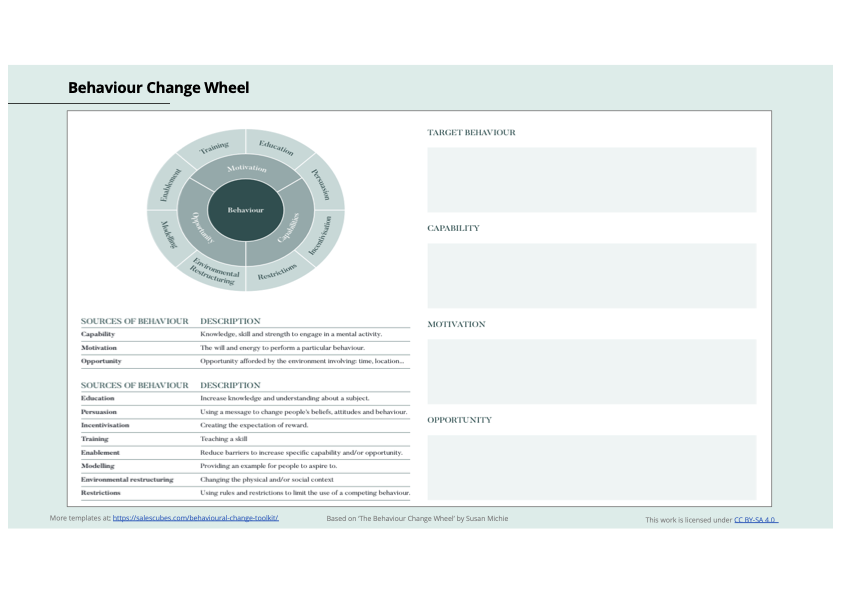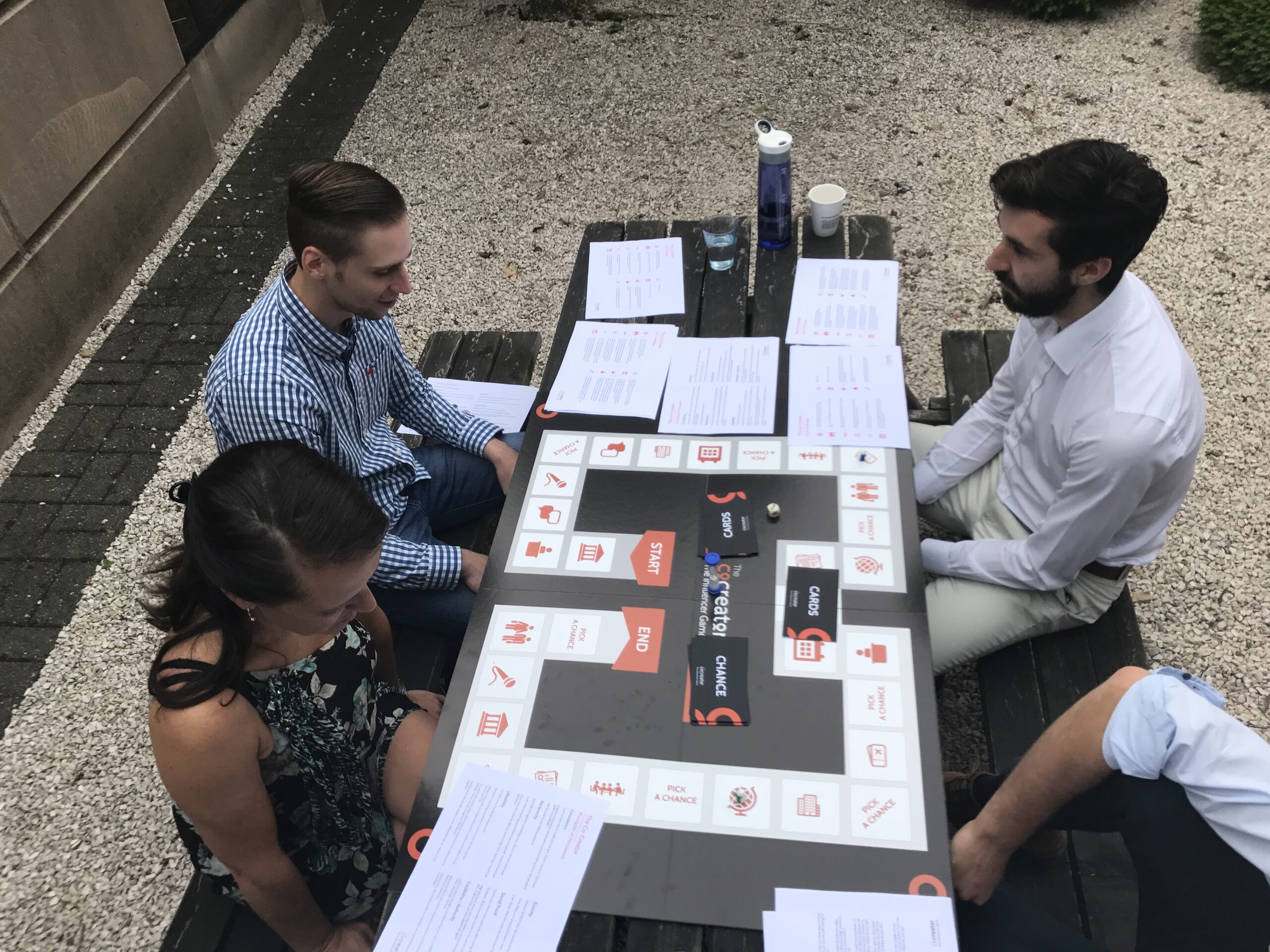What is it?
The Behavioural Change Wheel is a tool designed to help understand and bring about change in behaviour. Imagine a wheel: at its centre is the behaviour you want to change. Surrounding this are various components that influence behaviour, like a series of spokes and layers that support and direct the wheel. This wheel is not just about identifying what needs to change but also about understanding the ‘how’ and ‘why’ behind these changes.

 Sour:ce: Dr. Lou Atkins (Auteur), Prof. Robert West (Auteur), Prof. Susan Michie, May 2014, The Behaviour Change Wheel
Sour:ce: Dr. Lou Atkins (Auteur), Prof. Robert West (Auteur), Prof. Susan Michie, May 2014, The Behaviour Change WheelUseful for:
The Behavioural Change Wheel is used for:
-
- Understanding Behaviour: It helps in breaking down the factors that contribute to a particular behaviour.
-
- Designing Change Strategies: By identifying these factors, it becomes easier to develop targeted strategies for change.
-
- Implementing Change: It provides a structured approach to modifying behaviour, whether in individuals, groups, or larger populations.
Application:
This tool is incredibly versatile and can be applied in various scenarios, such as:
-
- In Health Promotion: For designing campaigns that encourage healthier lifestyle choices.
-
- In Organizational Change: To help employees adopt new processes or cultural shifts.
-
- In Personal Development: For individuals looking to change their habits or behaviours.
Process:
Step 1: Define the Behaviour
Identify the behaviour you want to change. Be as specific as possible.
Step 2: Understand the Behaviour
Analyse the behaviour in-depth. What triggers it? What are its consequences? What are the beliefs and attitudes surrounding it?
Step 3: Identify Influencing Factors
Look at the factors that influence this behaviour. These can be internal, like a person’s skills or emotions, or external, like their physical environment or social influences. We call them the sources of behaviour.
| Sources of Behaviour | Description |
| Capability: Psychological | Knowledge, skill and strength to engage in a mental activity |
| Capability: Physical | Physical skill, strength |
| Motivation: Automatic | Automatic response, reflex |
| Motivation: Reflective: | The reflective process involving the plans and evaluations to perform a particular behaviour. |
| Opportunity: Physical | Opportunity afforded by the environment involving: time, location … |
| Opportunity: Social | Opportunity afforded due to interpersonal influence. |
Example:
Target Behaviour Hospital staff to disinfect their hands using alcohol gel in identified high risk situations.
| COM-B components | What needs to happen for the target behaviour to occur? | Is there a need for change? |
| Physical capability | Have the physical skills to clean hands | No change needed as hospital staff have these skills |
| Psychological capability | Know the correct technique to clean hands | No change needed as knowledge of hand cleaning techniques is sufficient |
| Know how to create ‘if-then’ rules to prompt hand cleaning | Change needed as hospital staff do not necessarily know how to create and routinely apply if-then rules | |
| Physical opportunity | Have alcohol gel available | No change needed as gel is available at each bedside |
| Social opportunity | See senior health professionals clean their hands using alcohol gel | Change needed as staff do not always see seeing senior health professionals cleaning their hands using alcohol gel |
| Reflective motivation | Hold beliefs that using alcohol gel more frequently will reduce infection transmission | No change needed as research literature shows staff old these beliefs |
| Believing that consistent hand hygiene will require improved cognitive and self-regulation skills | Change needed as staff do not necessarily recognise the value of these skills | |
| Automatic motivation | Have established routines and habits for hand cleaning | Change needed to establish routine and habit formation |
Step 4: Develop Intervention Strategies:
Based on your understanding, develop strategies that address these influencing factors. This could involve education, motivation, or changes in the environment.
| Intervention Function | Description |
| Education | Increase knowledge and understanding about a subject. |
| Persuasion | Using a message to change people’s beliefs, attitudes and behaviour. |
| Incentivisation | Creating the expectation of reward. |
| Coercion | Making or changing the rules / laws. |
| Training | Teaching a skill |
| Enablement | Reduce barriers to increase specific capability and/or opportunity. |
| Modelling | Providing an example for people to aspire to. |
| Environmental restructuring | Changing the physical and/or social context |
| Restrictions | Using rules and restrictions to limit the use of a competing behaviour. |
Example:
| Intervention function | Definition | Example of intervention function |
| Education | Increasing knowledge or understanding | Providing information to promote healthy eating |
| Persuasion | Using communication to induce positive or negative feelings or stimulate action | Using imagery to motivate increases in physical activity |
| Incentivisation | Creating an expectation of reward | Using prize draws to induce attempts to stop smoking |
| Coercion | Creating an expectation of punishment or cost | Raising the financial cost to reduce excessive alcohol consumption |
| Training | Imparting skills | Advanced driver training to increase safe driving |
| Restriction | Using rules to reduce the opportunity to engage in the target behaviour (or to increase the target behaviour by reducing the opportunity to engage in competing behaviours) | Prohibiting sales of solvents to people under 18 to reduce use for intoxication |
| Environmental restructuring | Changing the physical or social context | Providing on-screen prompts for GPs to ask about smoking behaviour |
| Modelling | Providing an example for people to aspire to or imitate | Using TV drama scenes involving safe-sex practices to increase condom use |
| Enablement | Increasing means/reducing barriers to increase capability (beyond education and training) or opportunity (beyond environmental restructuring) | Behavioural support for smoking cessation, medication for cognitive deficits, surgery to reduce obesity, prostheses to promote physical activity |
Step 5: Implement the Change
Put your strategies into action. This might involve rolling out a program, conducting workshops, or making environmental adjustments.
Step 6: Evaluate and Adjust
Finally, evaluate the effectiveness of your changes. Are they working? If not, what can be adjusted for better results?
Sources
- Lou Atkins, Robert West, Susan Michie, 2014, The Behaviour Change Wheel, Silverback Publishing.
- Social Change UK. (n.d.). A guide on the COM-B Model of Behaviour.
- UK’s Medical Research Council, (2010-2013), Behavioural Change Techniques Taxonomy Projec, http://www.bct-taxonomy.com
- Michie, S., Richardson, M., Johnston, M., Abraham, C., Francis, J., Hardeman, W., Wood, C. E. (2013). The behaviour change technique taxonomy (v1) of 93 hierarchically clustered techniques: building an international consensus for the reporting of behaviour change interventions. Ann Behav Med, 46(1), 81-95.
- Barker, F., Atkins, L., & De Lusignan, S. (2016). Applying the COM-B behaviour model and behaviour change wheel to develop an intervention to improve hearing-aid use in adult auditory rehabilitation. International Journal of Audiology, 55(sup3), S90-S98.
Tool



